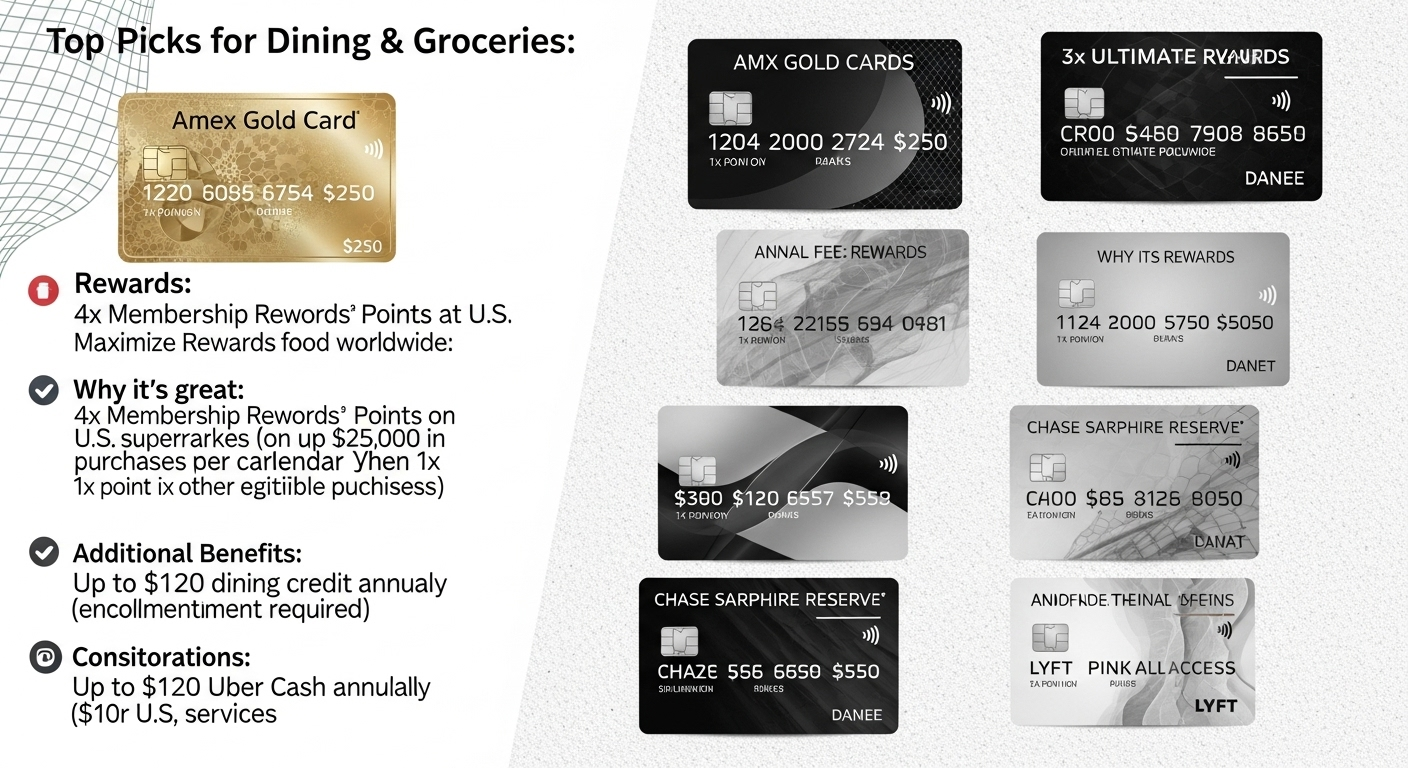Food spending is a major budget item for American households—averaging $5,703 annually on groceries and $3,250 on dining out, up 6-8% from 2024, according to the U.S. Bureau of Labor Statistics. For families or foodies shelling out $500+ monthly on supermarkets, restaurants, and takeout, that’s over $10,000 a year. The good news? Specialized credit cards can rebate 3%–6% back in cash, points, or credits—potentially saving $300–$600 annually. These cards turn everyday essentials into rewards for travel, cash, or more meals.
With 12+ years of experience reviewing rewards programs (contributing to The Points Guy and NerdWallet), I’ve analyzed 2025’s top options based on real-time issuer data, user reviews, and expert insights from sources like NerdWallet, CNN Underscored, and The Points Guy. This guide targets food lovers and families seeking versatile rewards on both dining (restaurants, delivery) and groceries (supermarkets, wholesale clubs). We’ll balance cash back simplicity with travel points flexibility, highlighting 2025 expansions like broader delivery app inclusion. Ready to optimize your food budget? Let’s explore.
Why Choose a Credit Card for Dining and Groceries in 2025?
These cards are game-changers for high food spenders, offering:
- Elevated Rewards: 3x–6% on U.S. supermarkets and dining, often uncapped or with high limits (e.g., $6,000/year at 6%).
- Welcome Bonuses: $200–$900 in value after minimal spend, funding vacations or gift cards.
- Additional Perks: Statement credits for delivery (e.g., $120/year DoorDash) or streaming ties-ins.
- Flexibility: Cash back for budgets or points for travel redemptions (1:1 to airlines/hotels).
In 2025, issuers like Amex and Capital One have expanded categories to include more delivery services (Uber Eats, DoorDash) and wholesale clubs (Costco, Sam’s), per NerdWallet and The Points Guy updates. J.D. Power’s 2025 satisfaction scores rank these cards at 810+/1,000 for value among everyday spenders. Pro tip: Use apps like WalletHub to calculate ROI based on your spend.
Top Picks: Best Credit Cards for Dining and Groceries
For households with $500/month food spend, prioritize cards covering both categories. Based on 2025 ratings from NerdWallet and CNN Underscored (factoring rewards rates, fees, and bonuses), here’s a comparison of the top five.
| Card Name | Annual Fee | Grocery Rewards | Dining Rewards | Welcome Bonus | Key Perks | Best For |
|---|---|---|---|---|---|---|
| Blue Cash Preferred® Card from American Express | $0 intro, then $95 | 6% cash back (U.S. supermarkets, up to $6K/year) | 3% cash back (select U.S. streaming, transit) | $250 statement credit after $3K spend in 6 months | $84 Disney Bundle credit; 6% on transit | Heavy grocery shoppers |
| American Express® Gold Card | $325 | 4x points (U.S. supermarkets, up to $25K/year) | 4x points (restaurants worldwide) | 90,000 points after $6K spend in 6 months ($900 value) | $120 dining credit (Grubhub, etc.); $120 Uber credit | Foodie travelers |
| Capital One Savor Cash Rewards Credit Card | $0 | 3% cash back (groceries, excluding superstores) | 4% cash back (dining, entertainment) | $200 cash + $100 travel after $500 spend in 3 months | No foreign fees; 8% on Capital One Entertainment | Budget food lovers |
| Bank of America® Customized Cash Rewards Credit Card | $0 | 3% cash back (choice category, incl. groceries/dining) | 3% cash back (if dining chosen) | $200 cash after $1K spend in 90 days | Up to 75% bonus with Preferred Rewards | BofA clients |
| Chase Sapphire Preferred® Card | $95 | 2x points (groceries via Chase portal) | 3x points (dining, delivery) | 75,000 points after $4K spend in 3 months ($937 travel) | $50 hotel credit; 1:1 transfers to airlines | Travel + food hybrids |
The Blue Cash Preferred leads NerdWallet’s 2025 grocery rankings for its 6% rate, while Amex Gold excels in combined dining/grocery per The Points Guy. On $500 monthly food spend ($300 groceries, $200 dining), Blue Cash Preferred yields $18/month ($216/year) post-fee.
Card Breakdown: Detailed Rewards and Perks
- Blue Cash Preferred: Earn 6% on $6,000 in U.S. supermarkets (then 1%), ideal for families. Pairs with 3% on transit/streaming. 2025 update: Includes more wholesale clubs.
- Amex Gold: 4x on groceries (up to $25K) and dining worldwide; redeem points for 1¢ each or 1:1 transfers. $240 annual credits offset fee for $500+ spenders.
- Capital One Savor: Unlimited 3% groceries + 4% dining; no-fee entry for beginners. Ties into entertainment for date nights.
- BofA Customized Cash: Choose 3% on groceries or dining quarterly; boosts to 5.25% with Preferred Rewards (for $100K+ balances).
- Chase Sapphire Preferred: 3x dining + portal bonuses for groceries; points worth 1.25¢ via Chase Travel or transfers.
Pros/Cons: Weighing the Trade-Offs
- Blue Cash Preferred: Pros: Top grocery rate; easy cash redemptions. Cons: $6K cap; 2.7% foreign fees.
- Amex Gold: Pros: High combined rates; premium perks. Cons: $325 fee; caps after $25K.
- Capital One Savor: Pros: No fee/caps; broad categories. Cons: Excludes Walmart/Target for groceries.
- BofA Customized Cash: Pros: Flexible categories; no fee. Cons: Quarterly choice limits; base 1% elsewhere.
- Chase Sapphire Preferred: Pros: Travel multipliers; insurance. Cons: Lower grocery base; $95 fee.
How to Choose: Match to Your Food Habits
- > $300/Month Groceries? Blue Cash Preferred’s 6% maximizes savings (ROI +$150/year post-fee).
- Frequent Dining + Travel? Amex Gold or Sapphire Preferred for points (e.g., 4x = $200 value on $500 spend).
- No Fee Preferred? Capital One Savor or BofA for 3-4% without costs.
- Wholesale Clubs? Check exclusions (e.g., Amex includes Costco 2025).
Calculate: (Monthly spend × rate) + bonus/credits – fee = annual value. Tools like NerdWallet’s simulator help.
FAQ: Credit Cards for Dining and Groceries
Does Costco count as groceries?
Yes for Amex Blue Cash (6%), but not Capital One Savor (excludes superstores).
Best no-fee card for food spending?
Capital One Savor: 3% groceries + 4% dining, unlimited.
How do dining credits work?
Enroll via app (e.g., Amex Gold: $10/month at Grubhub); auto-credits on eligible charges.
Worth the fee for $500/month spend?
Yes for Blue Cash Preferred: Breakeven at $158/month groceries.
In summary, the Blue Cash Preferred is ideal for grocery-heavy households, while Amex Gold suits balanced foodies. Apply today to cut food costs. Rates/fees apply; approval not guaranteed.

